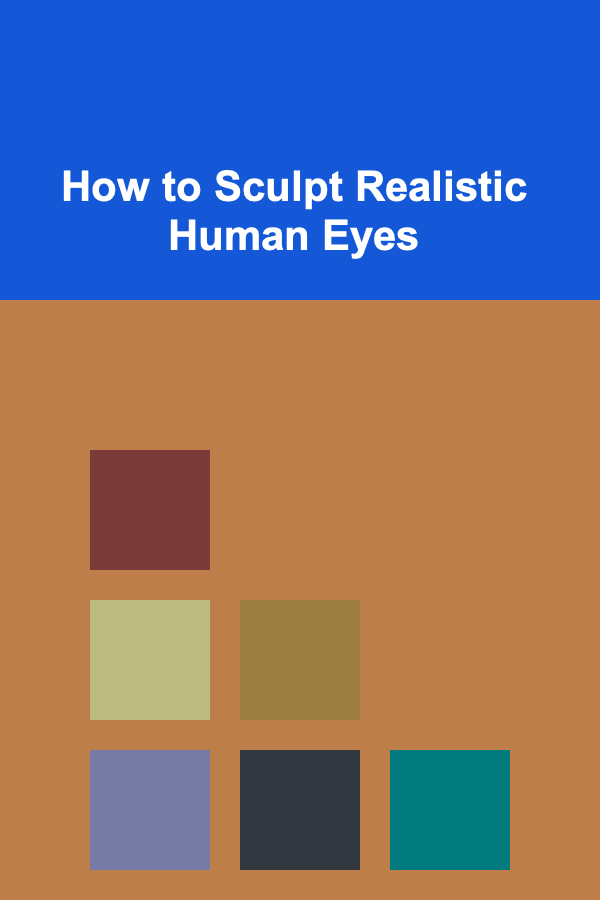
How to Sculpt Realistic Human Eyes
ebook include PDF & Audio bundle (Micro Guide)
$12.99$9.99
Limited Time Offer! Order within the next:

Sculpting realistic human eyes is one of the most challenging yet rewarding tasks in the field of sculpture. Eyes are often referred to as the "windows to the soul," and their realism can greatly influence the overall expression and believability of the sculpture. Whether you're working with clay, wax, or digital media, mastering the art of sculpting human eyes can elevate your work to a new level of realism.
In this guide, we will break down the process of sculpting realistic human eyes in detail. From understanding the anatomy of the eye to adding intricate details that make your sculpture come to life, this article will provide you with the necessary tools and techniques to sculpt eyes that seem almost alive.
Understanding the Anatomy of the Eye
Before you begin sculpting, it's essential to understand the anatomy of the human eye. The eye is a highly complex and sensitive organ, and its structure is key to achieving a realistic sculpture. Here are the main components of the human eye:
1.1. The Eyeball
The eyeball is a spherical structure that sits in the socket of the skull, and it's the main element of the eye. It is about the size of a small marble and contains various important structures:
- Cornea: The transparent layer at the front of the eye that helps to focus light.
- Pupil: The black circular opening in the center of the eye that allows light to enter.
- Iris: The colored part of the eye surrounding the pupil. The iris controls the size of the pupil.
- Sclera: The white part of the eye that surrounds the iris and pupil. It's usually opaque but can reveal veins and subtle texture.
1.2. The Eyelids
The eyelids cover and protect the eyeball. They are made of thin, flexible skin and are capable of closing to shield the eye from foreign objects or light. The shape, movement, and position of the eyelids play a critical role in the expression of the eyes.
- Upper Eyelid: This eyelid is more mobile and covers part of the cornea, especially when the eye is closed.
- Lower Eyelid: This is less mobile and typically just covers the lower portion of the sclera when the eye is open.
1.3. The Tear Duct and Lacrimal Gland
The lacrimal gland is located at the upper part of the eye socket, producing tears to keep the eye moist. The tears drain through the tear duct located in the corner of the eye, near the nose.
1.4. The Iris and Pupil Detail
The iris contains intricate details like fibers, ridges, and a subtle gradient of color. The pupil size can vary depending on the lighting, emotions, and stimuli around the eye. Sculpting the iris and pupil correctly will require you to capture this subtle complexity.
1.5. The Eyelashes
Eyelashes, though often overlooked in sculpture, can add a lot of life and realism to your sculpture. They grow along the upper and lower eyelids, with the upper lashes being thicker and longer than the lower ones.
Materials for Sculpting Realistic Eyes
Choosing the right material is crucial for sculpting realistic eyes. Different materials offer various benefits, depending on your artistic goals, skill level, and desired finish.
2.1. Clay
Clay is one of the most common materials for sculpting realistic eyes. There are several types of clay to choose from, including:
- Oil-based Clay: This is an excellent option for creating detailed and smooth textures. It doesn't dry out and remains malleable, which is ideal for long working sessions.
- Water-based Clay: A more traditional option that can be harder to smooth but is suitable for beginners and offers a quicker drying time.
- Polymer Clay: A versatile option that can be baked to harden it. It's great for creating small-scale sculptures and fine details.
2.2. Wax
Wax is another material that can produce incredibly realistic sculptures, especially for finer, delicate features. It's especially effective for casting eyes, where you can create the shape in wax and then use the mold to cast in another material, like resin or metal.
2.3. Silicone and Resin
For artists working in hyperrealistic sculpture, silicone or resin can be used for the eyeball itself. Silicone, in particular, can create the glossy and translucent quality of the cornea, while resin is a good choice for casting the entire eye.
2.4. Digital Sculpting Tools
In the digital age, many artists use programs like ZBrush or Blender to sculpt eyes. These digital tools allow for extreme precision and allow artists to focus on very fine details, such as skin texture, iris fibers, and scleral veins.
The Sculpting Process: Step-by-Step
3.1. Start with the Eye Socket
To begin, the eye is not an isolated object but is deeply embedded within the face. Sculpt the eye socket first to ensure the correct placement and alignment of the eye.
- Form the Base: Start by shaping the orbital socket. The eye should sit naturally within the bony structure of the skull. Study the bone structure of the face, especially the upper orbital ridge, lower orbital ridge, and nasal bone.
- Add a Ball for the Eyeball: Create a small, spherical shape that will serve as the eyeball. Ensure this is a little larger than the socket to give the impression of the eyeball's natural position. You can use a ball of clay or a similar round object to serve as a reference.
3.2. Sculpt the Eyeball
Once the socket is formed, focus on the shape and details of the eyeball.
- Spherical Shape: The eye should remain a perfect sphere, with a slight indentation for the pupil.
- Cornea and Pupil: Use a smaller tool or your fingers to create the indentation for the pupil. This indentation should be deep enough to show a clear contrast between the black of the pupil and the surrounding iris.
- Sclera Detail: Add the sclera by texturing the white part of the eye. This area should have subtle veins and texture for a natural appearance.
3.3. Sculpt the Iris
The iris is a critical part of the eye and has a complex structure.
- Create a Base Shape: The iris is slightly raised and encircles the pupil. Sculpt the iris by gently building up the area around the pupil.
- Add Detail: The iris is not a flat, smooth surface. It has texture, such as radial lines and fibers that spread out from the center. Use a fine sculpting tool or a needle to create these lines, ensuring they have a natural flow.
3.4. Sculpt the Eyelids
The eyelids play an important role in both the functionality and aesthetic of the eye.
- Upper Eyelid: Begin by shaping the upper eyelid to fit snugly against the cornea. The upper eyelid should have a subtle crease, especially if you are sculpting a human figure.
- Lower Eyelid: Sculpt the lower eyelid gently so that it curves around the bottom of the eyeball. The lower eyelid typically covers only a small portion of the sclera.
- Ensure Symmetry: Take extra care to ensure that both eyelids are symmetrical, especially if you're sculpting a human face. Use a soft, steady hand to avoid creating harsh lines.
3.5. Sculpting the Tear Duct and Lacrimal Gland
The tear duct is located in the inner corner of the eye, and the lacrimal gland is slightly above it. Add this detail by gently pressing the clay in this area to create the characteristic small indentation where the tear duct resides.
3.6. Add Final Details
Once you've sculpted the basic shape, it's time to refine the details.
- Eyelashes: Use small pieces of clay or other materials to create the appearance of eyelashes. Be mindful of their direction and natural curvature. The upper lashes should be longer and more densely packed, while the lower lashes are finer and shorter.
- Eyebrows: Eyebrows can add significant expression and realism to your sculpture. Sculpt the underlying shape of the brow bone first and then add individual hairs or groups of hairs to give texture.
Painting and Finishing Touches
Sculpting the basic structure of the eye is only part of the process. To bring your eye to life, you will need to paint and add subtle finishes.
4.1. Base Colors
For realism, it's important to paint the sclera, iris, and pupil with base colors before adding details.
- Sclera: Paint the sclera a very pale, almost translucent white. Add slight washes of blue or red to mimic veins.
- Iris: Paint the iris in layers, starting with the base color and then layering various shades to add depth and texture.
- Pupil: The pupil should be pure black and may appear slightly shiny depending on the light source.
4.2. Adding Texture and Depth
Once the base colors have dried, add texture to the iris and sclera. Use finer paintbrushes to add the intricate details of the iris fibers and veins. Consider using a magnifying glass to closely observe the details in a real eye for inspiration.
4.3. Gloss and Shine
To achieve the glossy, wet look of a real eye, use a gloss varnish on the iris and cornea. The eye should reflect light, giving it a lifelike appearance. Ensure that the gloss is evenly applied without overdoing it, as too much shine can make the eye look unnatural.
4.4. Final Touches
Finally, add any additional details such as highlights on the sclera or subtle touches to the eyelashes. These small, finishing touches will make your sculpture feel polished and complete.
Conclusion
Sculpting realistic human eyes is a skill that requires patience, attention to detail, and an understanding of anatomy. By following the steps outlined in this guide, you can create eyes that seem alive, with depth and expression. Whether you're working in traditional media like clay or wax or using digital tools, the key to success lies in the careful study of the human eye and the commitment to refining every detail. By taking the time to perfect your techniques, you'll be able to create eyes that captivate and bring your sculptures to life.
Reading More From Our Other Websites
- [Organization Tip 101] How to Use Planters to Define Areas in Your Yard
- [Personal Finance Management 101] How to Build and Stick to a Realistic Budget
- [Personal Investment 101] Turn Your Deep Learning Skills into Passive Income
- [Small Business 101] Best Remote Team Collaboration Tools for Micro‑Consultancies
- [Home Holiday Decoration 101] How to Make DIY Holiday Decorations for a Personal Touch
- [Gardening 101] Essential Tips for Growing a Thriving Container Garden
- [Stamp Making Tip 101] From Hobby to Art: How to Start Your Own Stamp-Making Journey
- [Organization Tip 101] How to Create a Remote Work Success Toolkit
- [Personal Investment 101] How to Create Profitable AI Solutions for Passive Income
- [Home Maintenance 101] How to Clean and Care for Your Washing Machine

Using Deep Learning to Build Scalable Passive Income Streams
Read More
Reducing Your Home's Heating and Cooling Needs: A Comprehensive Guide
Read More
Mastering Gluten-Free Cookies: A Comprehensive Guide
Read More
How to Use a Healthy Habits Planner for Postpartum Recovery
Read More10 Tips for Entertainment Expense Tracking with Spreadsheet Software
Read More
10 Tips for a Romantic Holiday Planning Checklist
Read MoreOther Products

Using Deep Learning to Build Scalable Passive Income Streams
Read More
Reducing Your Home's Heating and Cooling Needs: A Comprehensive Guide
Read More
Mastering Gluten-Free Cookies: A Comprehensive Guide
Read More
How to Use a Healthy Habits Planner for Postpartum Recovery
Read More10 Tips for Entertainment Expense Tracking with Spreadsheet Software
Read More